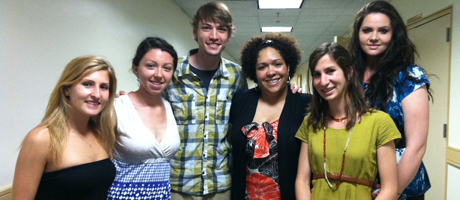Two local nonprofits received a financial boost thanks to a unique grant-making initiative in a GW service-learning class.
Students in a human services course taught by Adjunct Professor Peter Konwerski awarded Safe Shores, a children’s advocacy center, and Kid Power, which provides educational programming to underserved D.C. youth, $2,500 and $7,500, respectively, through their “George Washington University Human Services Foundation” and “Commitment to Service” grant competition. The grants were announced at the 2011 Service Learning Symposium April 26 held in GW’s Marvin Center.
“It was a great feeling being able to give real money to two organizations that do needed work in the D.C. community,” said senior Elizabeth Barnett, who chaired the foundation’s board. “Kid Power and Safe Shores both provided comprehensive and well-written grants, which made our jobs easy when deciding on how to distribute our foundation money.”
Max Skolnik, executive director and founder of Kid Power, said his organization was honored to receive money from the students’ foundation.
“These funds will help D.C. youth learn about nutrition, get their hands dirty in community gardens, cook delicious treats with the produce they grow, and support local service projects and advocacy efforts focused on healthy eating,” he said. “GW is helping District students and their families integrate nutrition into their daily lives.”
The class received the grant money from the Learning by Giving program of the Sunshine Lady Foundation, created by Doris Buffet, sister of billionaire financier Warren Buffet, to invest in organizations and programs dedicated to providing opportunities for the advancement of education, well-being and new life choices for disadvantaged people. The Learning by Giving program supports and promotes the study of philanthropy at the undergraduate level nationwide.
Louise Sawyer, a consultant to the Learning by Giving program, said the program is based on the idea that giving “actual money” to college students would fully engage them “as leaders and problem solvers in their community.”
“The effectiveness of this approach has been demonstrated year after year as the program has grown, with everyone involved expressing great enthusiasm over its impact – from the students themselves, to the universities and the nonprofits in the community,” she said.
“This gift from the Sunshine Lady Foundation created a powerful learning opportunity for our students which amplified our existing departmental focus on service-learning in an unprecedented way” said Dr. Konwerski. “As professor, I was fortunate to facilitate the class, but also equally impressed with how our students put their extensive non-profit knowledge into action as they took on the necessary team and leadership roles to make these grants happen for our community partners who so desperately need these funds to support their programs.”
During the semester, the students divided into three teams to identify applicants and select the finalists. Ms. Barnett and senior Josh Bailey led the foundation’s board, senior Jessica Sokol helped manage the team which created the initial requests for proposals, and seniors Matthew Donahue and Stephanie Mayer led the foundation’s evaluation team, which created an evaluation rubric and coordinated quantitative ranking and qualitative review during the selection process.
Amy Cohen, executive director of GW’s Center for Civic Engagement and Public Service, said the Sunshine Lady Foundation encourages direct involvement with the local organizations in the running for grant money—a vital part of any service-learning course.
“I think that grant making is one of the most effective tools to learn how to analyze and solve community needs and solutions,” said Ms. Cohen. “The Sunshine Lady Foundation is great because they ask students to do direct service and get to know organizations at the grassroots level even as they evaluate strategy, innovation and effectiveness. I am so glad that the students have an effective learning tool and that the organizations benefit from service and funding.”
Ms. Barnett said the class was “a great real-world experience.”
“As human services majors, most of the students in the class have spent years focusing and learning about the service side of nonprofit organizations,” she said. “This class project was a wonderful opportunity for us to learn about another side.”


